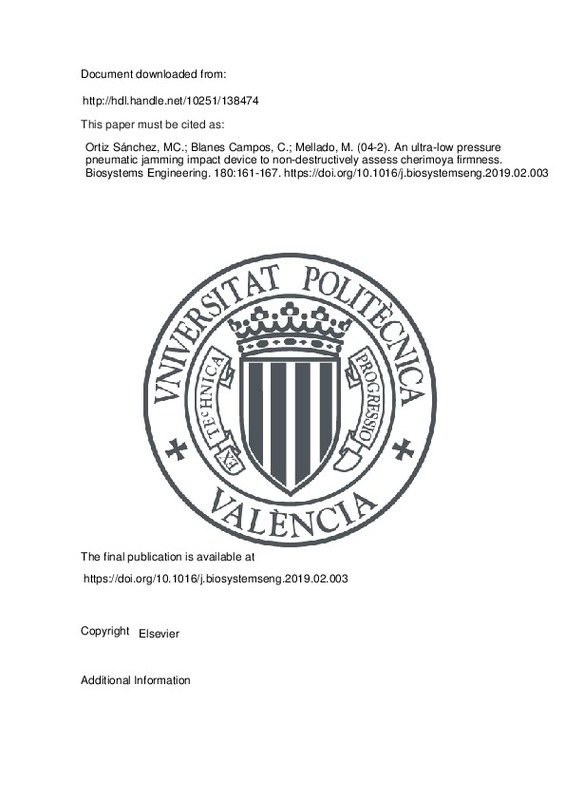JavaScript is disabled for your browser. Some features of this site may not work without it.
Buscar en RiuNet
Listar
Mi cuenta
Estadísticas
Ayuda RiuNet
Admin. UPV
An ultra-low pressure pneumatic jamming impact device to non-destructively assess cherimoya firmness
Mostrar el registro sencillo del ítem
Ficheros en el ítem
| dc.contributor.author | Ortiz Sánchez, María Coral
|
es_ES |
| dc.contributor.author | Blanes Campos, Carlos
|
es_ES |
| dc.contributor.author | Mellado, Martin
|
es_ES |
| dc.date.accessioned | 2020-03-06T13:25:38Z | |
| dc.date.available | 2020-03-06T13:25:38Z | |
| dc.date.issued | 2019-04 | es_ES |
| dc.identifier.issn | 1537-5110 | es_ES |
| dc.identifier.uri | http://hdl.handle.net/10251/138474 | |
| dc.description.abstract | [EN] The quality of cherimoya fruit is reduced by the rapid deterioration of firmness during ripening. Different methods have been developed for the measurement of firmness. The objective of this study was to use a developed impact prototype for the non-destructive assessment and prediction of cherimoya fruit firmness. The prototype has an ultra-low pressure pneumatic jamming rod used to copy the irregular fruit shape. A sample of 200 cherimoyas from Málaga (Spain) `Fino de Jete¿ were tested during 4 days. Every day all the fruits were non-destructively tested and a set of 15 were destructively tested. On the fourth day all the remaining fruits were also destructively tested. The prototype was capable of copying the irregularities of the fruit and non-destructively assessing the decrease in cherimoya firmness during ripening without causing damage. A high correlation was found between destructive firmness and non-destructive variables from the prototype. A PLS model was developed to relate destructive firmness from day 4 to non-destructive variables and diameter from day 3, with a R2 of 75.6 and a RMSECV of 0.9885. A calibration set confirmed the prediction with a R2 of 80.2 and a RMSEP of 0.0561. Firmness decay could be non-destructively predicted 24 h in advance using the variables extracted from the prototype device signal. | es_ES |
| dc.language | Inglés | es_ES |
| dc.publisher | Elsevier | es_ES |
| dc.relation.ispartof | Biosystems Engineering | es_ES |
| dc.rights | Reserva de todos los derechos | es_ES |
| dc.subject | Fruit quality | es_ES |
| dc.subject | Prediction | es_ES |
| dc.subject | Prototype | es_ES |
| dc.subject | Deceleration signal | es_ES |
| dc.subject | Non-damaging | es_ES |
| dc.subject.classification | INGENIERIA DE SISTEMAS Y AUTOMATICA | es_ES |
| dc.subject.classification | INGENIERIA AGROFORESTAL | es_ES |
| dc.title | An ultra-low pressure pneumatic jamming impact device to non-destructively assess cherimoya firmness | es_ES |
| dc.type | Artículo | es_ES |
| dc.identifier.doi | 10.1016/j.biosystemseng.2019.02.003 | es_ES |
| dc.rights.accessRights | Abierto | es_ES |
| dc.contributor.affiliation | Universitat Politècnica de València. Departamento de Ingeniería de Sistemas y Automática - Departament d'Enginyeria de Sistemes i Automàtica | es_ES |
| dc.contributor.affiliation | Universitat Politècnica de València. Departamento de Ingeniería Rural y Agroalimentaria - Departament d'Enginyeria Rural i Agroalimentària | es_ES |
| dc.description.bibliographicCitation | Ortiz Sánchez, MC.; Blanes Campos, C.; Mellado, M. (2019). An ultra-low pressure pneumatic jamming impact device to non-destructively assess cherimoya firmness. Biosystems Engineering. 180:161-167. https://doi.org/10.1016/j.biosystemseng.2019.02.003 | es_ES |
| dc.description.accrualMethod | S | es_ES |
| dc.relation.publisherversion | https://doi.org/10.1016/j.biosystemseng.2019.02.003 | es_ES |
| dc.description.upvformatpinicio | 161 | es_ES |
| dc.description.upvformatpfin | 167 | es_ES |
| dc.type.version | info:eu-repo/semantics/publishedVersion | es_ES |
| dc.description.volume | 180 | es_ES |
| dc.relation.pasarela | S\378919 | es_ES |







![[Cerrado]](/themes/UPV/images/candado.png)

